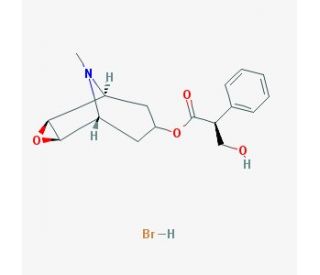

(−)-Scopolamine hydrobromide (CAS 114-49-8)
QUICK LINKS
(−)-Scopolamine hydrobromide is utilized extensively in research focused on the nervous system, where it acts as a competitive antagonist at muscarinic acetylcholine receptors. Neuroscientists also employ it to simulate the effects of cholinergic system disruptions, which are characteristic of certain neurological conditions, to better understand their pathophysiology. In botanical studies, the compound serves to investigate the biosynthesis of tropane alkaloids in plants, as well as their ecological role in plant defense mechanisms. Additionally, (−)-Scopolamine hydrobromide is used in the field of ophthalmology research, where its application helps in evaluating the processes involved in pupil dilation and accommodation reflexes.
(−)-Scopolamine hydrobromide (CAS 114-49-8) References
- Effects of scopolamine in comparison with apomorphine and phencyclidine on prepulse inhibition in rats. | Jones, CK. and Shannon, HE. 2000. Eur J Pharmacol. 391: 105-12. PMID: 10720641
- LC determination of atropine sulfate and scopolamine hydrobromide in pharmaceuticals. | Ceyhan, T., et al. 2001. J Pharm Biomed Anal. 25: 399-406. PMID: 11377019
- Pharmacokinetics and pharmacodynamics in clinical use of scopolamine. | Renner, UD., et al. 2005. Ther Drug Monit. 27: 655-65. PMID: 16175141
- A novel spray-dried nanoparticles-in-microparticles system for formulating scopolamine hydrobromide into orally disintegrating tablets. | Li, FQ., et al. 2011. Int J Nanomedicine. 6: 897-904. PMID: 21720502
- [Pharmacokinetics of scopolamine hydrobromide oral disintegrative microencapsule tablets in Beagle dogs determined with LC-MS/MS]. | Xia, T., et al. 2011. Yao Xue Xue Bao. 46: 951-4. PMID: 22007521
- Scopolamine as an antidepressant: a systematic review. | Jaffe, RJ., et al. 2013. Clin Neuropharmacol. 36: 24-6. PMID: 23334071
- Scopolamine and methylscopolamine differentially affect fixed-consecutive-number performance of male and female Wistar rats. | van Haaren, F., et al. 1989. Pharmacol Biochem Behav. 33: 361-5. PMID: 2813474
- Canagliflozin prevents scopolamine-induced memory impairment in rats: Comparison with galantamine hydrobromide action. | Arafa, NMS., et al. 2017. Chem Biol Interact. 277: 195-203. PMID: 28837785
- The relative selectivity of anticholinergic drugs for the M1 and M2 muscarinic receptor subtypes. | Burke, RE. 1986. Mov Disord. 1: 135-44. PMID: 2904117
- Ginsenoside Compound K Regulates Amyloid β via the Nrf2/Keap1 Signaling Pathway in Mice with Scopolamine Hydrobromide-Induced Memory Impairments. | Yang, Q., et al. 2019. J Mol Neurosci. 67: 62-71. PMID: 30535776
- Rodent models for dry eye syndrome: Standardization using benzalkonium chloride and scopolamine hydrobromide. | Chaudhari, P., et al. 2023. Life Sci. 317: 121463. PMID: 36731648
- An examination of central actions characteristic of scopolamine: comparison of central and peripheral activity in scopolamine, atropine and some synthetic basic esters. | Aparkes, MW. 1965. Psychopharmacologia. 7: 1-19. PMID: 5830966
- Effects of scopolamine hydrobromide on the development of the chick and rabbit embryo. | McBride, WG., et al. 1982. Aust J Biol Sci. 35: 173-8. PMID: 7126057
- The effects of scopolamine on memory for time in rats and pigeons. | Santi, A. and Weise, L. 1995. Pharmacol Biochem Behav. 51: 271-7. PMID: 7667339
- Solid-state stereochemistry of (-)-scopolamine hydrobromide sesquihydrate, a new polymorph of the anticholinergic drug. | Michel, A., et al. 1994. J Pharm Sci. 83: 508-13. PMID: 8046605
Ordering Information
| Product Name | Catalog # | UNIT | Price | Qty | FAVORITES | |
(−)-Scopolamine hydrobromide, 1 g | sc-203259 | 1 g | $130.00 |
